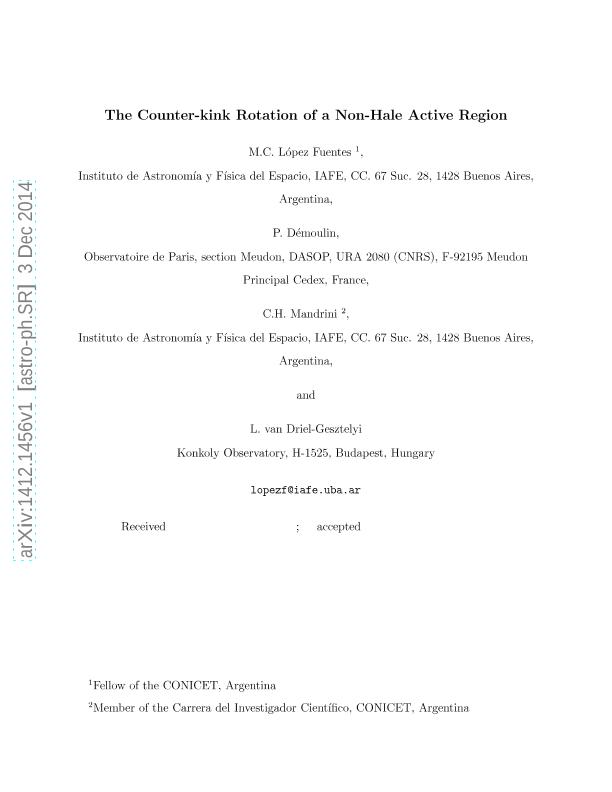Mostrar el registro sencillo del ítem
dc.contributor.author
Lopez Fuentes, Marcelo Claudio

dc.contributor.author
Démoulin, Pascal

dc.contributor.author
Mandrini, Cristina Hemilse

dc.contributor.author
van Driel Gesztelyi, Lidia

dc.date.available
2017-08-17T21:12:17Z
dc.date.issued
2000-11
dc.identifier.citation
Lopez Fuentes, Marcelo Claudio; Démoulin, Pascal; Mandrini, Cristina Hemilse; van Driel Gesztelyi, Lidia; The Counterkink Rotation of a Non-Hale Active Region; IOP Publishing; Astrophysical Journal; 544; 1; 11-2000; 540-549
dc.identifier.issn
0004-637X
dc.identifier.uri
http://hdl.handle.net/11336/22634
dc.description.abstract
We describe the long-term evolution of a bipolar non-Hale active region that was observed from 1995 October to 1996 January. During these four solar rotations the sunspots and subsequent flux concentrations, during the decay phase of the region, were observed to move in such a way that by December their orientation conformed to the Hale-Nicholson polarity law. The sigmoidal shape of the observed soft X-ray coronal loops allows us to determine the sense of the twist in the magnetic configuration. This sense is confirmed by extrapolating the observed photospheric magnetic field, using a linear force-free approach, and comparing the shape of computed field lines with the observed coronal loops. This sense of twist agrees with that of the dominant helicity in the solar hemisphere where the region lies, as well as with the evolution observed in the longitudinal magnetogram during the first rotation. At first sight the relative motions of the spots may be misinterpreted as the rising of an Omega loop deformed by a kink instability, but we deduce from the sense of their relative displacements a handedness for the flux-tube axis (writhe) that is opposite to that of the twist in the coronal loops and, therefore, to what is expected for a kink-unstable flux tube. After excluding the kink instability, we interpret our observations in terms of a magnetic flux tube deformed by external motions while rising through the convective zone. We compare our results with those of other related studies, and we discuss, in particular, whether the kink instability is relevant to explain the peculiar evolution of some active regions.
dc.format
application/pdf
dc.language.iso
eng
dc.publisher
IOP Publishing

dc.rights
info:eu-repo/semantics/openAccess
dc.rights.uri
https://creativecommons.org/licenses/by-nc-sa/2.5/ar/
dc.subject
Solar Activity
dc.subject
Solar Corona
dc.subject
Solar Interior
dc.subject
Solar Magnetic Fields
dc.subject.classification
Astronomía

dc.subject.classification
Ciencias Físicas

dc.subject.classification
CIENCIAS NATURALES Y EXACTAS

dc.title
The Counterkink Rotation of a Non-Hale Active Region
dc.type
info:eu-repo/semantics/article
dc.type
info:ar-repo/semantics/artículo
dc.type
info:eu-repo/semantics/publishedVersion
dc.date.updated
2017-08-16T18:06:03Z
dc.journal.volume
544
dc.journal.number
1
dc.journal.pagination
540-549
dc.journal.pais
Reino Unido

dc.journal.ciudad
Londres
dc.description.fil
Fil: Lopez Fuentes, Marcelo Claudio. Consejo Nacional de Investigaciónes Científicas y Técnicas. Oficina de Coordinación Administrativa Ciudad Universitaria. Instituto de Astronomía y Física del Espacio. - Universidad de Buenos Aires. Facultad de Ciencias Exactas y Naturales. Instituto de Astronomía y Física del Espacio; Argentina
dc.description.fil
Fil: Démoulin, Pascal. Centre National de la Recherche Scientifique. Observatoire de Paris; Francia
dc.description.fil
Fil: Mandrini, Cristina Hemilse. Consejo Nacional de Investigaciónes Científicas y Técnicas. Oficina de Coordinación Administrativa Ciudad Universitaria. Instituto de Astronomía y Física del Espacio. - Universidad de Buenos Aires. Facultad de Ciencias Exactas y Naturales. Instituto de Astronomía y Física del Espacio; Argentina
dc.description.fil
Fil: van Driel Gesztelyi, Lidia. Centre National de la Recherche Scientifique. Observatoire de Paris; Francia
dc.journal.title
Astrophysical Journal

dc.relation.alternativeid
info:eu-repo/semantics/altIdentifier/url/https://arxiv.org/abs/1412.1456
dc.relation.alternativeid
info:eu-repo/semantics/altIdentifier/url/http://iopscience.iop.org/article/10.1086/317180
dc.relation.alternativeid
info:eu-repo/semantics/altIdentifier/doi/http://dx.doi.org/10.1086/317180
Archivos asociados
